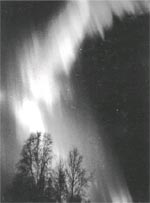The light show
 a specially designed satellite of the us National Space and Aeronautical Administration ( nasa ) has tracked the electrons moving out from the Earth's poles. These electrons are believed to be the cause of the mysterious "dark aurora' that breaks up the curtains of light in the auroral displays. Aurora borealis (or the northern lights) is a bright and colourful display of light seen in the atmosphere during the evening. This display is visible only from the higher latitudinal zone in the Northern Hemisphere, thus the name northern lights.
a specially designed satellite of the us National Space and Aeronautical Administration ( nasa ) has tracked the electrons moving out from the Earth's poles. These electrons are believed to be the cause of the mysterious "dark aurora' that breaks up the curtains of light in the auroral displays. Aurora borealis (or the northern lights) is a bright and colourful display of light seen in the atmosphere during the evening. This display is visible only from the higher latitudinal zone in the Northern Hemisphere, thus the name northern lights.
Magnetic field lines surrounding the Earth act like guide wires, forcing the electrons and other charged particles, streaming out from the Sun, to travel along them towards the poles. As these converge towards the poles, electrons speed up, becoming highly energised. "It is analogous to water speeding up as it is forced through a nozzle,' says Charles Carlson, an astronomer at the University of California at Berkley. When these electrons hit the atmosphere, around 300 km above the surface, they generate the colourful displays of the northern lights ( New Scientist , Vol 164, No 2218).
But how these electrons are drained out of the poles (or else the poles will become highly charged) has puzzled the scientists for a long time. To search the path of departing electrons, Carlson and his colleagues at nasa designed and built the Fast Auroral Snapshot Satellite ( fast ), which went into orbit in 1996. This satellite has the capability of picking up electrons and other charged particles moving in any direction.
Speaking at the American Geophysical Union in San Francisco, Carlson reported that fast has found electrons streaming out of the poles as well as into them, thus completing the auroral electric circuit. These electrons do not collide with atoms in the atmosphere at fast enough speeds to produce light. They cannot reach high speeds until they leave the ionosphere.
He added that dark auroras, which break up the curtains of auroral displays, could be result of the rising electrons moving too slowly to generate electromagnetic radiation. " fast has given us a very detailed picture of the aurora,' says Thomas Hallinan, a geophysicist at the University of Alaska Fairbanks.
Related Content
- Global resources outlook 2024
- Order of the Supreme Court regarding the of land of DSIIDC at Ranikhera-Mundka which was reserved for waste management, 31/07/2023
- Electric vehicles market monitor for light-duty vehicles: China, Europe, United States, and India, 2022
- Global EV outlook 2023
- Order of the National Green Tribunal regarding management of waste in village Dughneri, Hamirpur, Himachal Pradesh, 19/04/2023
- Order of the National Green Tribunal regarding cutting of trees for a tiger safari project, Corbett Tiger Reserve, 17/04/2023
